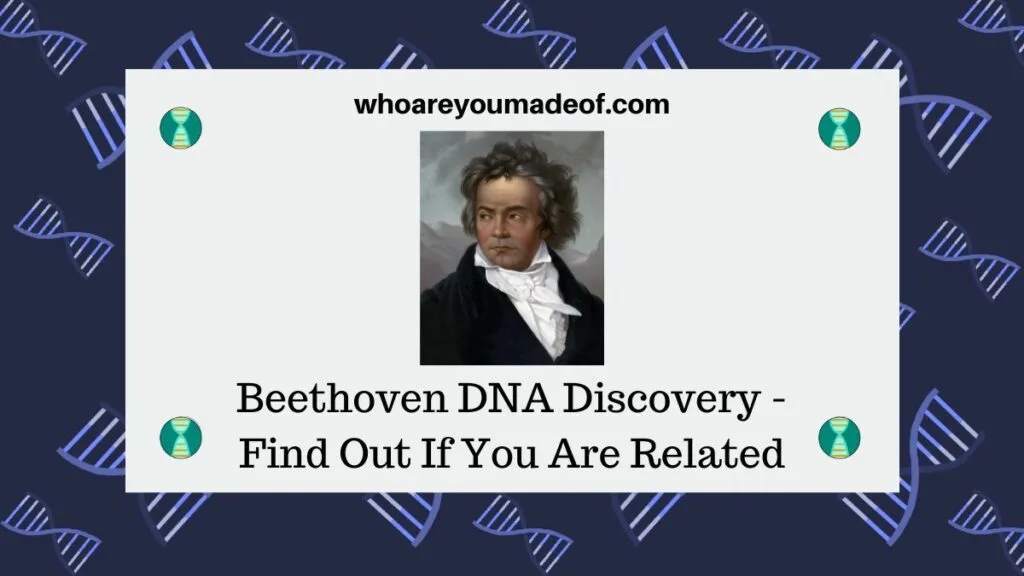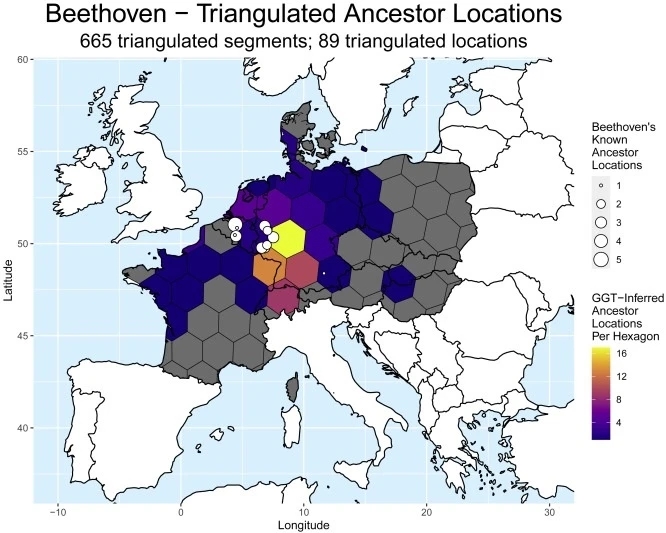Maybe you've heard that researchers have made big discoveries about Beethoven's DNA. In this post, learn more about what they learned, as well as how to find out if you are related to Beethoven.

This Beethoven DNA study is pretty cool for many reasons, including the fact that the study was published for anyone to read and his DNA is now included in a popular company's database. This means that Beethoven's living relatives can learn about their direct connection to the famous composer.
How did they get Beethoven's DNA from his hair?
For many years, scientists were only able to get nuclear DNA from hair if the root was included in the hair sample. Many times, such as when hair is cut and not pulled out, the root is not attached to the hair strand.
In 2019, a scientist by the name of Ed Green developed a way to get DNA from strands of hair with no root. This was big news for many types of scientists, law enforcement, and even genealogists.
The technique now used for getting DNA from a rootless strand of hair involves dissolving the hair in a special solution and then retrieving pieces of genetic material. Once enough DNA is acquired, it can all be put together - kind of like a puzzle.
Since DNA in rootless hair is in small pieces, a lot of hair is often needed to get a fairly complete DNA sample. In this particular study, they ended up needing more than 10 feet total of hair, which, remarkably, they were able to acquire.
All of this new research about Beethoven's life, illness and ancestry, is history coming full circle. After all, almost 200 years ago, Beethoven himself wrote that he wanted scientists to study his body to learn anything they could about his health conditions, particularly his hearing loss.
How can they be sure it was really Beethoven's hair?
Researchers were able to identify, acquire, and test eight samples of Beethoven's hair that came from different sources. Five of the samples were determined to belong to the same male, and two of those samples had reliable "chain of custody" documentation back to the source of the hair: Beethoven.
This gave the researchers confidence, as they describe in their report on the Beethoven DNA study, that all five of the samples belonging to the same male were in fact taken from Beethoven. The historical record describes how several people asked to keep a lock of Beethoven's hair after his death.
While the concept of giving away strands or locks of our hair might sound strange to those of us living in 2023, it was actually pretty normal to give away your hair in the early 1800s. During the years of Beethoven's life, it was considered normal to give away locks of hair as a keepsake to people who were very important to you or keep someone's hair who had recently passed away.
Later on in the 19th century, it was even popular to make jewelry that included human hair.
What is Beethoven's mtDNA haplogroup?
Beethoven's mtDNA was studied for this research, and his direct-line maternal haplogroup was shown to be H1b1+16,362C. Haplogroup H1 is very common in Europe, and the H1b subclade may be connected to ancient Eastern European populations.
What is Beethoven's Y-DNA haplogroup?
Researcher's determined that Beethoven's Y-DNA haplogroup is I-FT396000. This haplogroup was likely formed during the middle ages, with an Eastern or Central European origin.
Did they test Beethoven's autosomal DNA?
Yes, the genetic analysis of Beethoven's DNA included detailed analysis of his autosomal DNA. From this analysis, they were able to determine information about his recent ancestry, including a crude "ethnicity estimate".
Below, you will note that the brighter yellow and orange colors indicate where his ancestors came from, inferred by his DNA results, versus the white circles that show where his known genealogical ancestors were from.

Due to Beethoven's fame, both during and after his life, his ancestry has been the subject of a lot of speculation. Even though this particular image does not reveal the individual members of his family tree, it does illustrate that his ancestors were at least from the same regions of Europe where he thought they were from.
In addition to Beethoven's likely ancestral origins, the researchers worked with Family Tree DNA to access his autosomal DNA matches. Through researching his closest genetic relatives on Family Tree DNA Family Finder results, they were able to learn some details about his ancestors.
Is Beethoven's DNA publicly available?
Because researchers partnered with Family Tree DNA to find Y-DNA, mtDNA, and autosomal DNA matches, his DNA is now included in that company's DNA result database. This means that anyone who takes any of those DNA tests with FTDNA, or uploads to their website, can see if they are genetically related to Beethoven.
How to find out if you are related to Beethoven through DNA
If you have taken an autosomal DNA test or uploaded to Family Tree DNA, you can log in right now to see if Beethoven shows up as a DNA match to you. Those FTDNA customers who have tested their mtDNA or Y-DNA can also log in to see their matches and look for Beethoven.
It is important to note that we will only see Beethoven's information on our list if we match him. Unfortunately, I'm not related to him so he did not show up on my Family Finder list.
Anyone who has taken a DNA test with 23andMe (V3 or newer), Ancestry, or MyHeritage (2019 or newer) can download their DNA data from their testing site and upload it to Family Tree DNA for free. DNA matching typically takes a few days to complete, but if you are Beethoven's distant cousin, he might show up as a match.
And of course, if you are interested in learning whether you share a paternal or maternal haplogroup with Beethoven, you can order one of those tests directly from Family Tree DNA. If you do share a mtDNA or Y-DNA haplogroup with Beethoven, then you are related to him through your direct-line maternal or paternal ancestors, though depending on the genetic distance, it could be very far back in time.
Was Beethoven really a Van Beethoven?
Extra pair paternity events, also known as non-paternity events, are often discovered due to DNA testing. A DNA tester might learn that one of their parents was not their biological parent, or they might find out a similar discovery further back in their family tree.
Researchers learned through Y-DNA analysis, which examines the direct-line paternal ancestors, that Beethoven was likely not biologically descended from one of his paternal ancestors. The current working theory is that Beethoven's father, Johann van Beethoven, was not biologically descended from his grandfather, Ludwig van Beethoven.
They are able to know that he was not genetically descended from the Beethoven line because several known van Beethoven descendants were tested and our famous composer Beethoven does not share their exact Y-DNA haplogroup.
We can all help researchers continue to learn from Beethoven's DNA by uploading our DNA to the site, or taking an autosomal, mtDNA, or Y-DNA with Family Tree DNA. The more DNA matches who show up for Beethoven, the higher the probability that skilled researchers will be able to piece together his biological family tree.
Conclusion
I hope that you have found this article about Beethoven's DNA analysis interesting and that you consider checking to see if you match him, too. Maybe you will have more luck than I did and discover that you are a long-lost Beethoven cousin.
If you have any questions about something that you read in this article, or if you check your match list for Beethoven, please let me known in the discussion below.
Thanks for reading today!
